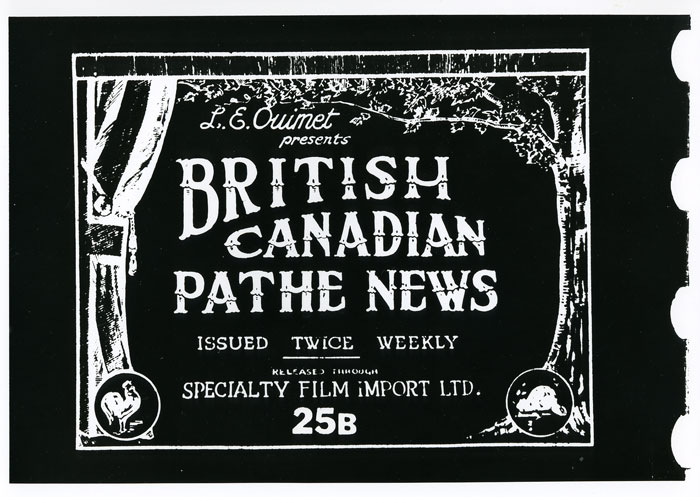Pioneer in the Canadian Film Industry
When a young boy of fifteen answered an ad for someone to learn the optical business, little did he know that he would be one of the early pioneers in the Canadian Motion Picture business, and indeed in North America. Mr. William Redpath came from a pioneering and inventive family who settled in the Keene are near Peterborough in 1820. Some of the family still resides there. Bill’s family had moved to the Kitchener area in 1900 where in 1902 his father, Walter Redpath, invented the Redpath Messenger Automobile. The last remaining one is preserved in the Canadian Automotive Museum in Oshawa, Ontario.
However young William did not want to move to Kitchener, and in 1901 he left school to join the Toronto firm of Charles Potter Optician. He found that they were making their own slides and this so interested young Bill, that very shortly after joining the firm, he was put in charge of this department.As there were no incandescent electric lamps available in those days, they used oxygen-hydrogen gas, which was made right on the premises. This gas was not only supplied to the local hospitals, but they also sold to travelling showmen for slide presentations. The gas was known in the trade as limelight – hence evolved the term “in the lime light”. In the early days the slides were used in churches for teaching and singing and the occasional illustrations for a travelling evening.
In 1906, Potter’s started to sell 35mm movie projectors, installing them in the few Nickelodeon theatres, where they charged five cents admission. The price of the projectors was $225.00. Bill used one of them and some of the films in his vaudeville act, which consisted of his nimble wit, a poor rendition on the xylophone, but ending with the high light of the evening – the motion picture show. For this, he charged $100.00 per evening and was in great demand. By now the toy was beginning to grow up and Bill left Potter’s taking with him their secretary, Alice as his wife and took on the management of the Pathescope Company of France who operated in Canada under Pathe’. He set up a department to make 35 and 28 mm films for industry and at one time had six cameramen and eight people in the Lab. Fox News, Canadian National News and many government films came out of the Pathe lab.
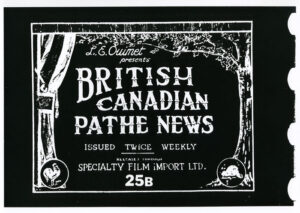
In 1912 and again in 1913, Bill headed up the Made in Canada Exhibition train, which was sponsored by the Manufactures’ Association of Canada and went from Toronto to the west coast of Canada. There would be advertisements well ahead of the train stops with all the hoop-la of a circus coming to town. The train would pull into a siding where the pictures would be shown on a sheet hung on the side of a boxcar. Virtually no one out west had seen a motion picture and it is estimated that over 300,000 people a year saw the films. These trips were to accomplish two things: to open up the film industry and to sell products. A telegram dated from the Canadian Pacific Railway dated, May 1913 says “Mr. Redpath in charge of the “Made in Canada Exhibition Train” requests that the same track, which was made up, on the last run be ready for this train. An engine with at least four thousand gallon capacity, tender placed next. Block and dynamo car next to the engine. Dining car at the other end. Also require two or three car cleaners on arrival. Train will leave Smith Falls (their first stop) with dining car next to Engine and dynamo car on rear. Very important that engine has full supply of water in order not to move train during the day. Signed H. B. Spender.”
There were many amusing incidents and Mr. Redpath tells of the time in 1916 when he and a film crew went down to film the hoisting of the centre span of the Quebec Bridge over the St. Lawrence, seven miles above Quebec City. The bridge was a cantilever type in having an independent truss unit suspended between the ends of two cantilever trusses on opposite sides of the river.The bridge in Quebec was not only a great achievement for the Canadian Bridge builders, but when completed would be the largest of its kind in the world. This would certainly be news! There was some delay in getting the truss into place, and being a hot day, Bill and the crew went to the nearest pub to whet their whistles, only to return too late to film the suspended truss breaking loose, and crashing into the river killing thirteen people. Not to be out done, Bill spent the entire night creating a 10-foot scale facsimile of the St. Lawrence setting and filming the collapse. The news film was a great success when shown and when an inquiry was to be made and the film used in the hopes of showing what might have gone wrong, Bill then had to confess to his use of trick photography.
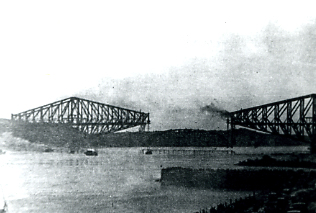
The early years were exciting and as time went on, Bill was more convinced of the use of films as a teaching aid. As a result he was also a pioneer in visual aids for the teaching profession. In the latter, he devoted most of his time to this new field. Although offered positions in the United States, Bill felt keenly that Canada offered him just as much challenge.
In 1961 the Canadian Picture Pioneers honoured him with a Special award and banquet; Bill treasured this honour given by his long time friends in business. In 1964, at the age of eighty, after a full and exciting life in a very rapidly developing industry, Bill died after a brief illness.
Canadian Pioneers Award 1941

Motion Pictures Pioneers Application 1940
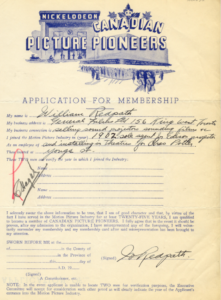
Embattled Shadows Pathescope
A History of Canadian Cinema, 1895-1939
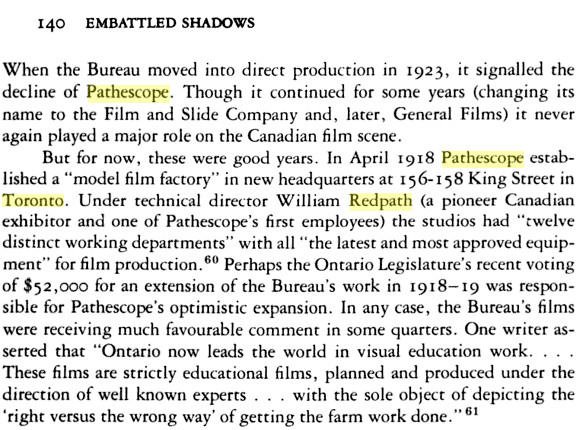
Rob Hopkins (age 2) with Great Great Grandfather William Redpath

Rob Hopkins and William Redpath
Please Contact Us for more info related to William Redpath
Pathescope Film Lab
https://www.youtube.com/watch?v=E8Viw8MI43E&feature=youtu.be&t=450

